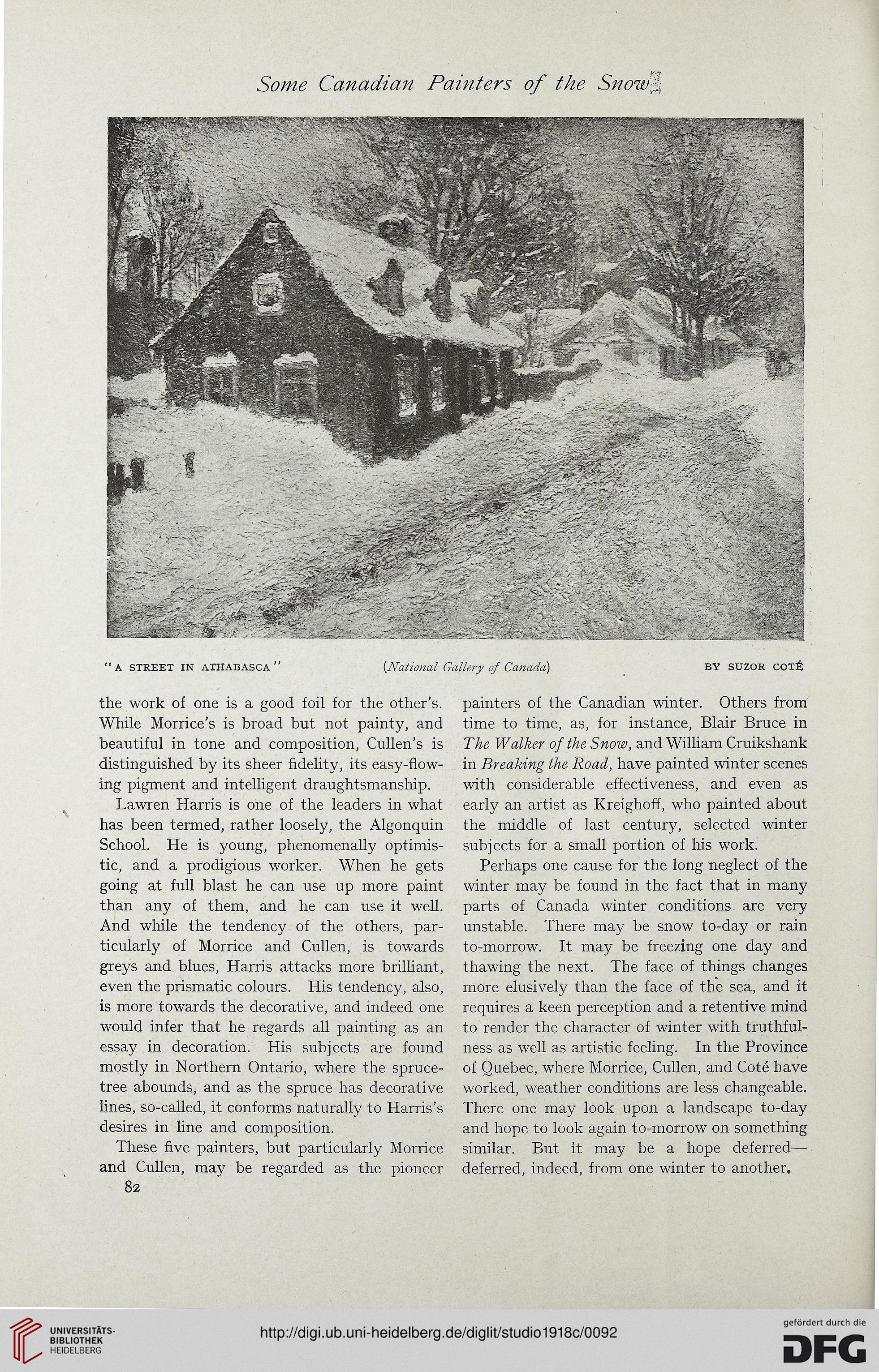Some Canadian Painters of the Snow.
"A STREET IN ATHABASCA"
the work of one is a good foil for the other's.
While Mortice's is broad but not painty, and
beautiful in tone and composition, Cullen's is
distinguished by its sheer fidelity, its easy-flow-
ing pigment and intelligent draughtsmanship.
Lawren Harris is one of the leaders in what
has been termed, rather loosely, the Algonquin
School. He is young, phenomenally optimis-
tic, and a prodigious worker. When he gets
going at full blast he can use up more paint
than any of them, and he can use it well.
And while the tendency of the others, par-
ticularly of Morrice and Cullen, is towards
greys and blues, Harris attacks more brilliant,
even the prismatic colours. His tendency, also,
is more towards the decorative, and indeed one
would infer that he regards all painting as an
essay in decoration. His subjects are found
mostly in Northern Ontario, where the spruce-
tree abounds, and as the spruce has decorative
lines, so-called, it conforms naturally to Harris's
desires in line and composition.
These five painters, but particularly Morrice
and Cullen, may be regarded as the pioneer
82
BY SUZOR COTE
painters of the Canadian winter. Others from
time to time, as, for instance, Blair Bruce in
The Walker oj the Snow, and WiUiam Cruikshank
in Breaking the Road, have painted winter scenes
with considerable effectiveness, and even as
early an artist as Kreighoff, who painted about
the middle of last century, selected winter
subjects for a small portion of his work.
Perhaps one cause for the long neglect of the
winter may be found in the fact that in many
parts of Canada winter conditions are very
unstable. There may be snow to-day or rain
to-morrow. It may be freezing one day and
thawing the next. The face of things changes
more elusively than the face of the sea, and it
requires a keen perception and a retentive mind
to render the character of winter with truthful-
ness as well as artistic feeling. In the Province
of Quebec, where Morrice, Cullen, and Cote have
worked, weather conditions are less changeable.
There one may look upon a landscape to-day
and hope to look again to-morrow on something
similar. But it may be a hope deferred—
deferred, indeed, from one winter to another.
{National Gallery of Canada)
"A STREET IN ATHABASCA"
the work of one is a good foil for the other's.
While Mortice's is broad but not painty, and
beautiful in tone and composition, Cullen's is
distinguished by its sheer fidelity, its easy-flow-
ing pigment and intelligent draughtsmanship.
Lawren Harris is one of the leaders in what
has been termed, rather loosely, the Algonquin
School. He is young, phenomenally optimis-
tic, and a prodigious worker. When he gets
going at full blast he can use up more paint
than any of them, and he can use it well.
And while the tendency of the others, par-
ticularly of Morrice and Cullen, is towards
greys and blues, Harris attacks more brilliant,
even the prismatic colours. His tendency, also,
is more towards the decorative, and indeed one
would infer that he regards all painting as an
essay in decoration. His subjects are found
mostly in Northern Ontario, where the spruce-
tree abounds, and as the spruce has decorative
lines, so-called, it conforms naturally to Harris's
desires in line and composition.
These five painters, but particularly Morrice
and Cullen, may be regarded as the pioneer
82
BY SUZOR COTE
painters of the Canadian winter. Others from
time to time, as, for instance, Blair Bruce in
The Walker oj the Snow, and WiUiam Cruikshank
in Breaking the Road, have painted winter scenes
with considerable effectiveness, and even as
early an artist as Kreighoff, who painted about
the middle of last century, selected winter
subjects for a small portion of his work.
Perhaps one cause for the long neglect of the
winter may be found in the fact that in many
parts of Canada winter conditions are very
unstable. There may be snow to-day or rain
to-morrow. It may be freezing one day and
thawing the next. The face of things changes
more elusively than the face of the sea, and it
requires a keen perception and a retentive mind
to render the character of winter with truthful-
ness as well as artistic feeling. In the Province
of Quebec, where Morrice, Cullen, and Cote have
worked, weather conditions are less changeable.
There one may look upon a landscape to-day
and hope to look again to-morrow on something
similar. But it may be a hope deferred—
deferred, indeed, from one winter to another.
{National Gallery of Canada)




